National Summary
AUSTRALIA’s feedbase remains highly variable, with weather patterns shaping pasture conditions.
Recent rainfall, temperature extremes, and storms have influenced green standing dry matter (GSDM) and total standing dry matter (TSDM) levels.
Widespread rainfall has improved biomass across Queensland, New South Wales, and south-eastern Australia, supporting pasture growth in key grazing areas. However, dry conditions persist in South Australia, Western Australia, and western Victoria, where limited moisture availability has restricted recovery.
Severe flooding in far north Queensland — more than 1000mm of rain — has disrupted operations, though its full impact on biomass is still being evaluated.
The Bureau of Meteorology reported January 2025 as the second warmest on record, intensifying soil moisture deficits. In February, there was a mix of rainfall, with above average levels in the east and north-west but drier conditions in the south and central Australia. Late February heat waves have added further stress to pastures, particularly in Western Australia’s Pilbara region, affecting ground cover and biomass retention.

Imagery and analysis provided by CiboLabs
February Total Standing Dry Matter
TSDM maps for February 2025 highlight the impact of weather variability on pasture biomass levels across the country.
- Northern & eastern Australia: Increased rainfall has supported biomass growth across Queensland and New South Wales, with many grazing regions now exceeding 1250–1750 kg DM/ha. Northern Queensland and the Top End (e.g., Charters Towers, Cooktown, Katherine) have seen notable increases, with some areas surpassing 2000 kg DM/ha.
- South-western WA: Inland regions remain critically dry, with biomass levels below 750 kg DM/ha. Some coastal districts such as around Esperance and Albany have recorded modest gains, although ongoing moisture stress remains a challenge for pasture conditions.
- Central & northern Australia: The Top End, Cape York, and northern Queensland have experienced strong biomass growth (1500–2000 kg DM/ha). Central Australia remains dry (<500 kg DM/ha), with few indications of substantial improvement.
- Western Victoria & south-eastern SA: Grazing areas around Hamilton and Horsham have seen biomass levels rise from 750–1250 kg DM/ha to 1250–1500 kg DM/ha. While in south-eastern SA the regions close to Mount Gambier and Naracoorte continue to experience only gradual improvements.
- South-eastern Australia: Above average summer rainfall has further supported pasture conditions in more broadly in Victoria, Tasmania, and south-eastern NSW. Gippsland and north-eastern Tasmania are now in the 1250–2000 kg DM/ha range, with parts of Tasmania exceeding 3000 kg DM/ha.
Decile rankings and seasonal comparisons
TSDM seasonal rankings for February 2025 provide insights into pasture trends compared to previous years.
- Victoria, NSW, Tasmania, and Queensland continue to see improvement, with more areas recording above average biomass levels.
- Western Australia shows ongoing deterioration, with a greater proportion of regions falling below the 40th percentile.
- South-eastern Australia: South-west Victoria has moved into the 70–90 decile range, with pockets exceeding the 90th percentile, reflecting positive seasonal conditions.
- South Australia: South-eastern SA aligns with Victoria’s improvements, though interior regions remain in the lower deciles (10–30), highlighting continued moisture deficits.
- Central Australia: Large areas remain in the lowest deciles (<10), though isolated rainfall events have led to minor localized improvements.
- Northern Australia: Significant gains across northern Queensland and the Top End have shifted many areas into mid-to-high deciles (50–80), reinforcing the impact of monsoonal rainfall on pasture biomass.
- Southwestern WA: Vegetation continues to decline, with many inland and coastal areas slipping into the lowest deciles (<20), signaling ongoing moisture stress and limited vegetation recovery.
Proportion of below, and above average decile areas by state
Fractional cover and vegetation trends
Fractional cover maps (7–22 February 2025) illustrate vegetation dynamics and pasture availability trends:
- Northern Australia: Green vegetation continues expanding across Queensland and the Top End, responding to monsoonal rainfall.
- Eastern Australia: Sustained green vegetation across New South Wales, Victoria, and Queensland reflecting the trends in the total standing dry matter images.
- South Australia: South-eastern regions show minor greening, while interior areas continue to be dominated by dry conditions.
- South-western WA: Minimal improvement is evident, with localized greening near coastal areas but persistent drying inland.
- Central Australia: Large areas remain in a bare-ground state, with little evidence of vegetation recovery.
Green standing dry matter (GSDM): Vegetation recovery
GSDM maps for February 2025 highlight variation in pasture recovery across different regions:
- South-eastern Australia: Green biomass has remained stable across New South Wales, Victoria, and Tasmania, with south-west Victoria (areas such as Hamilton and Warrnambool) maintaining high biomass levels (>3000 kg DM/ha).
- Western Victoria & south-eastern SA: Moderate improvements are observable, with Mount Gambier and Naracoorte reaching 1500–2000 kg DM/ha.
- Northern Australia: Strong increases in green biomass are evident, particularly in Charters Towers, Longreach, and Katherine (>1250–2000 kg DM/ha).
- South-western WA: Inland areas remain moisture-stressed, which is reflected by the low levels of green biomass (also noted in Fractional Cover) with <500 kg DM/ha, with only minor gains in some coastal zones.
- Central Australia: Limited change, with Alice Springs and Tennant Creek remaining below 250 kg DM/ha.
Dead standing dry matter (DSDM)
DSDM trends for February 2025 show:
- Northern Australia: Dead biomass continues declining in response to recent rainfall and green biomass growth.
- Southern states: Victoria, Tasmania, and southeastern South Australia have low dead biomass levels, reflecting improved pasture conditions.
- Central Australia: Dead biomass remains critically low (<250 kg DM/ha), reflecting arid conditions.
- Western & northern WA: Residual dead biomass remains in scattered pockets, though minor reductions suggest progressive decomposition.
Ground cover and vegetation density
Ground cover maps for February 2025 indicate:
- Central Australia: Extensive bare ground persists (>70 percent) in Alice Springs and Tennant Creek, with worsening trends.
- Western Australia: Bare ground is expanding across inland regions, while southwestern areas show localized stability.
- Northern Australia: While green cover remains stable, localized drying is evident in some grazing areas.
- Southeastern Australia: Dense vegetation cover remains dominant, particularly in Victoria and southeastern Queensland.
For more localised information including regional level overviews, users are encouraged to explore the Cibo Labs Regional Comparison. This tool provides regional data that may show the impact of localised weather or fire events. A further level of detail for individual properties is available for users who have created an Australian Feedbase Monitor account, which can be accessed both through the MyMLA portal or through the Cibo Labs website. These tools enable land managers to make data-informed decisions tailored to their unique feedbase conditions and needs.
The Cibo Labs National Comparison can be used to freely access these layers (https://www.cibolabs.com.au/products/national-comparsion/) to view the most recent images from a national, state or catchment level.
This tool can complement the Australian Feedbase Monitor which can also be created within the Cibo Labs Web Site www.cibolabs.com.au

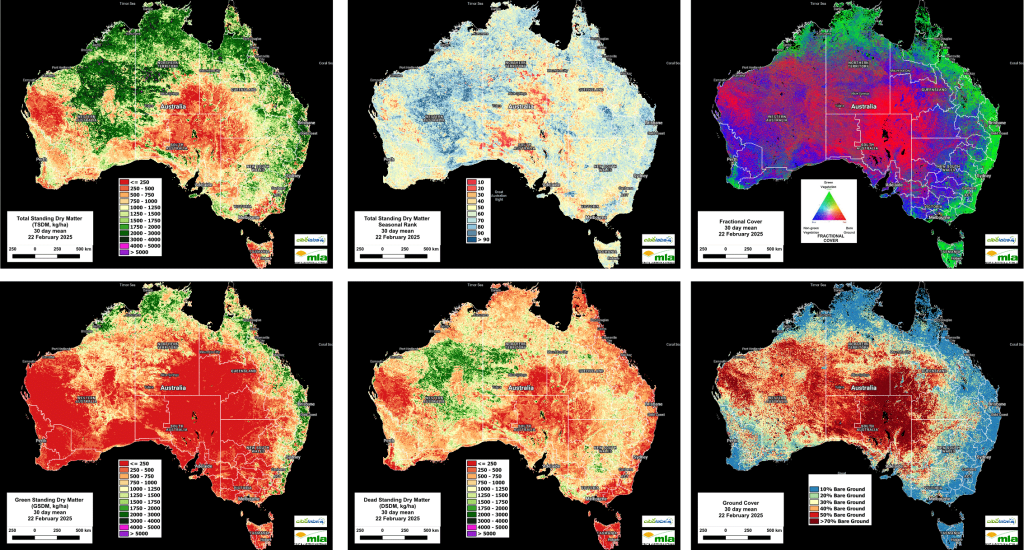
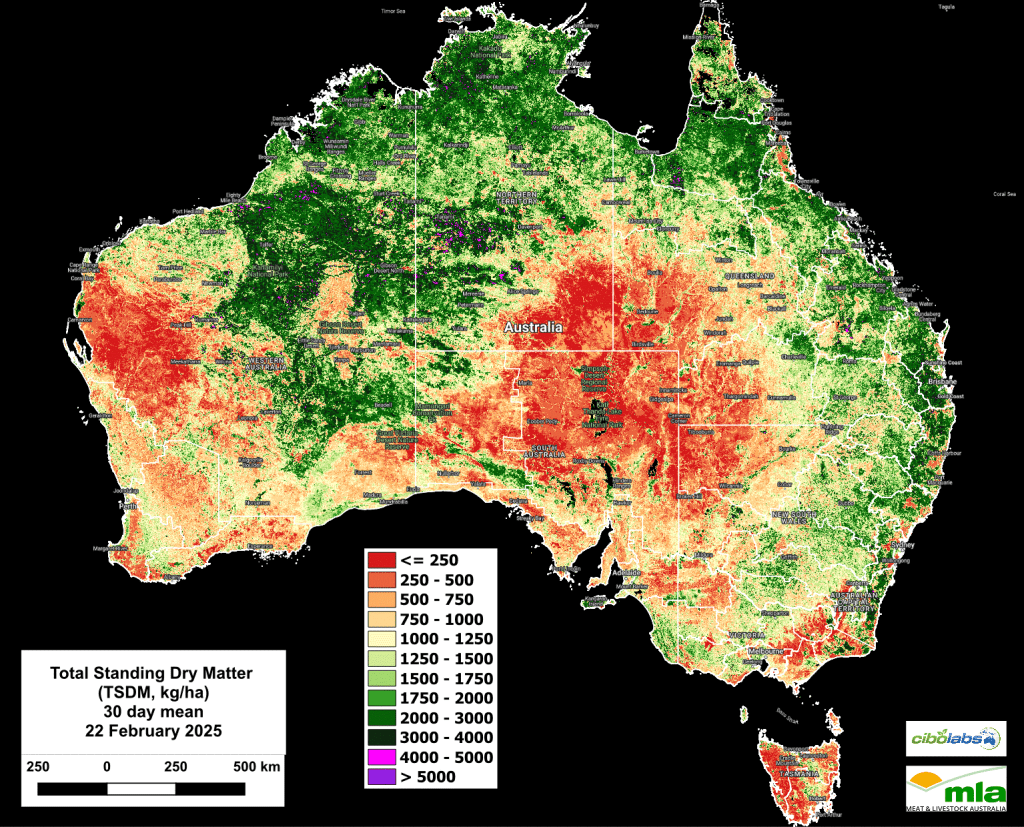
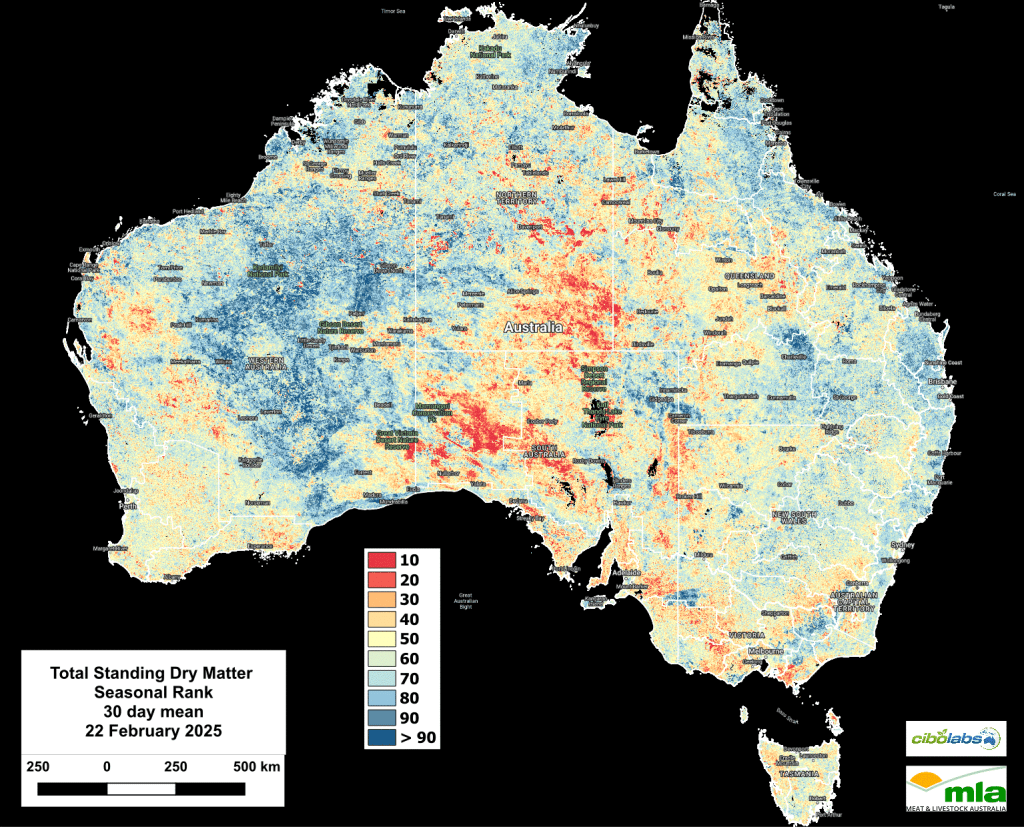
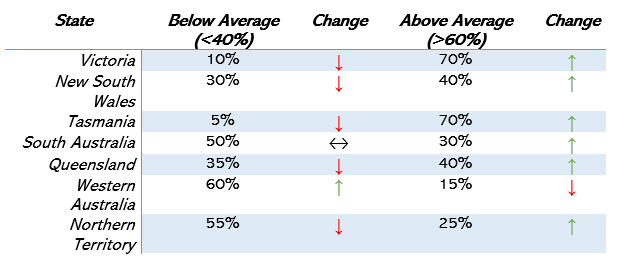
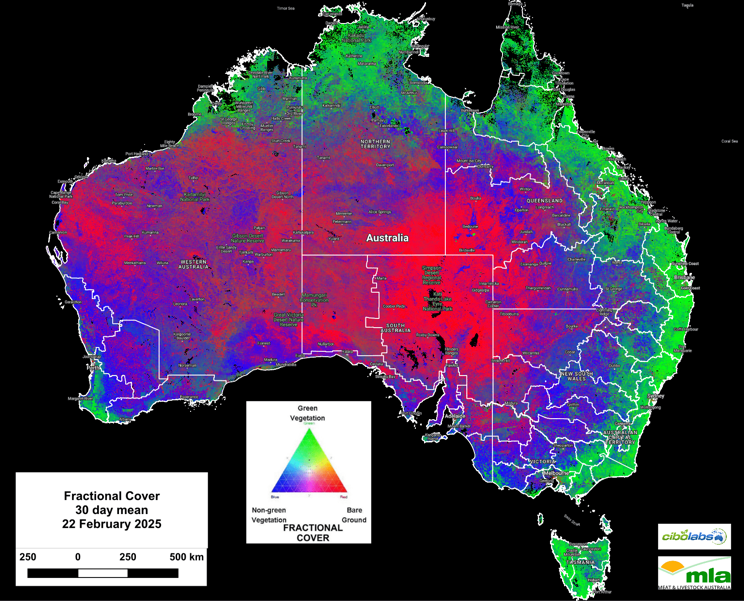
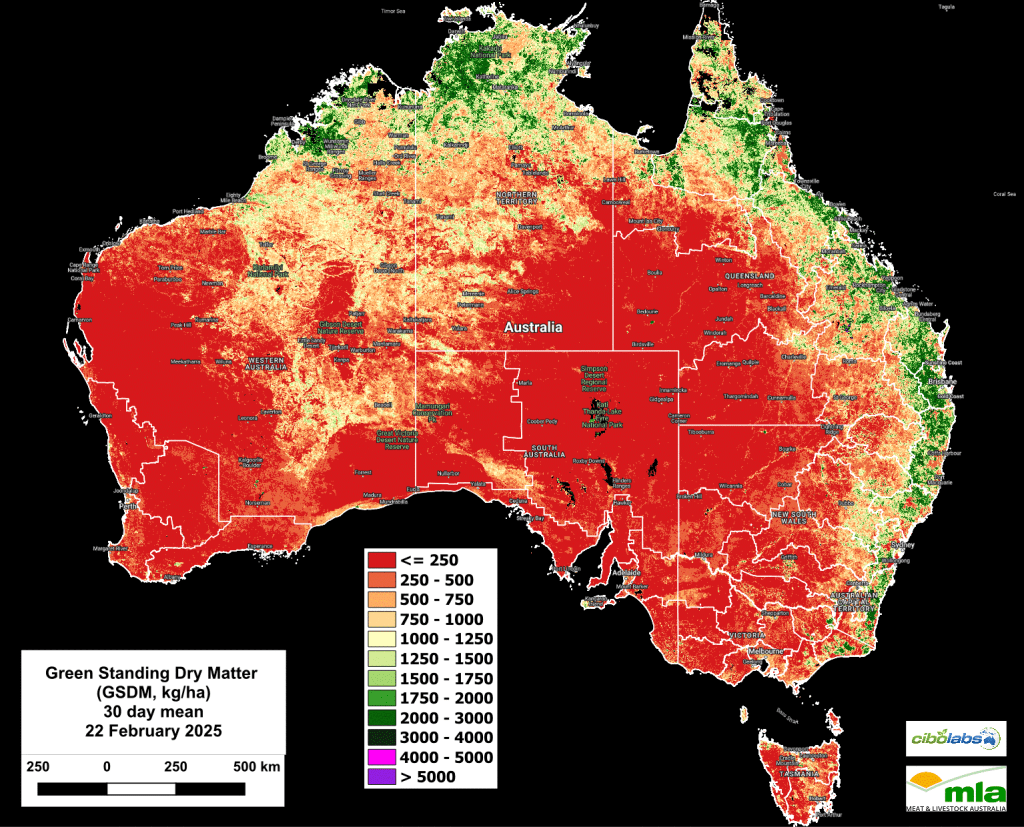
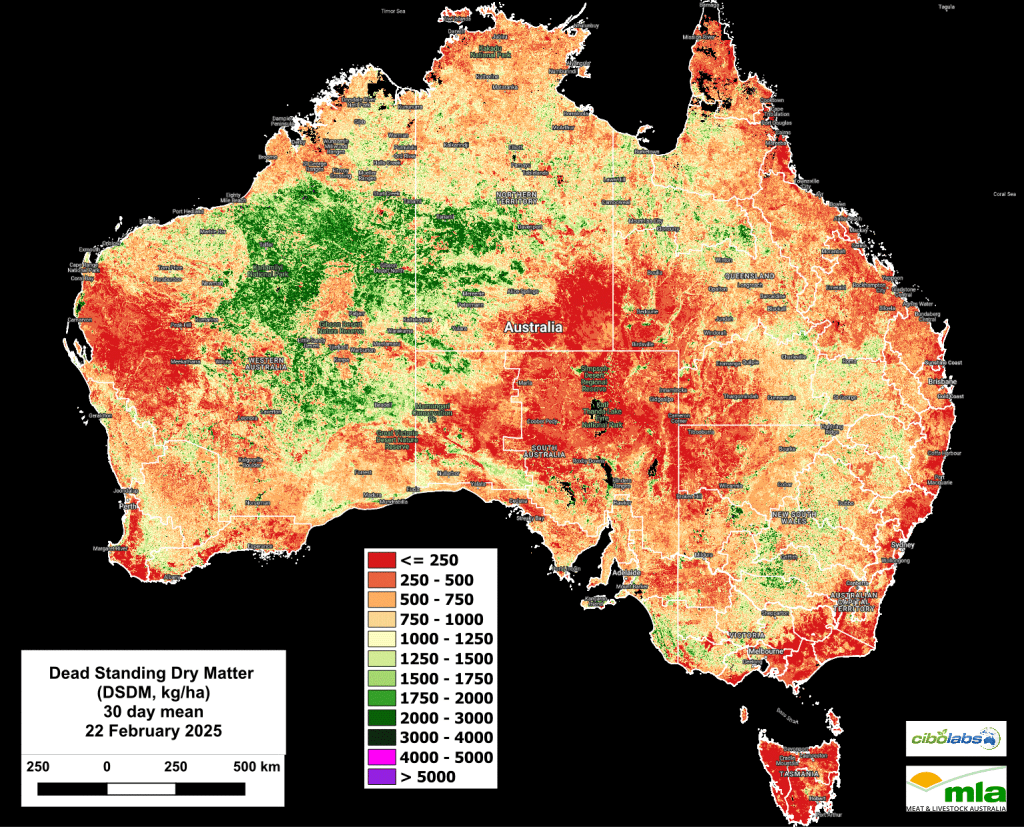
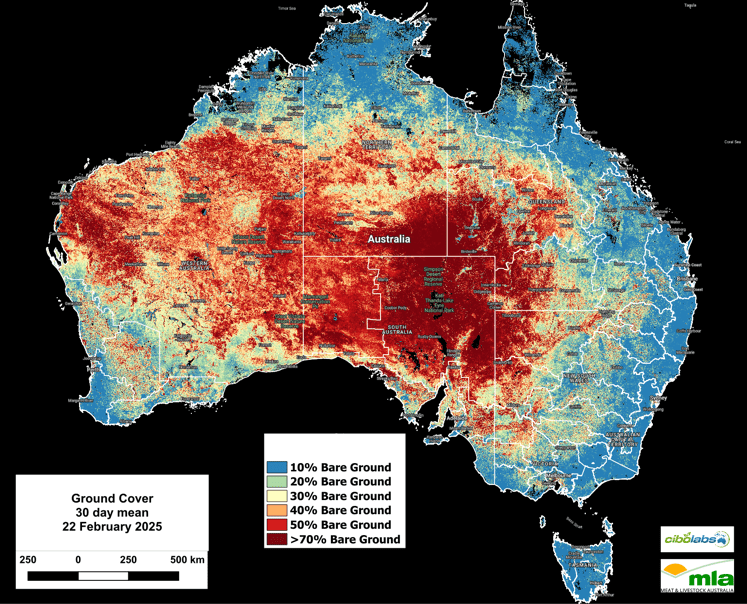
HAVE YOUR SAY